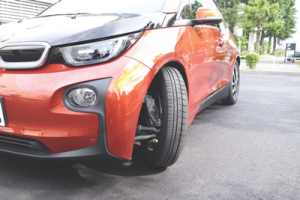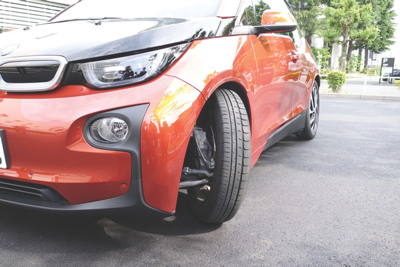Corporate Average Fuel Economy – better known as ‘CAFE’ – regulations were first enacted in the U.S. in 1975, in the wake of the panic-inducing Arab Oil Embargo (Google that for details).
CAFE standards are still with us today, and are intended to improve the average fuel economy of cars and light trucks, and the posted results on the sales placards of new cars and light trucks represent the sales-weighted average fuel economy of a vehicle maker’s fleet of current model year passenger vehicles.
If the average fuel economy of a manufacturer’s annual vehicle production falls below the defined standard, the manufacturer must pay a penalty of $5.50 per 0.1 mpg under the standard multiplied by the manufacturer’s total U.S. market production.
In 2012, the Obama Administration raised the CAFE standards from 27.5 mpg to a new goal of 54.5 mpg by 2025. Because of the way the government measures fuel economy, what we’ll see on new vehicle window stickers (which are closer to the actual mileage drivers can expect in more real-world driving conditions) is closer to about 36 miles per gallon.
Still, the tough new CAFE standards represent an incredible increase in fuel efficiency and are put- ting intense pressure on automakers. When the OEMs feel pressured, it pretty much automatically flows downhill to their suppliers – certainly down to tire manufacturers.

Technology Approaches
Across the board, everyone we talked to was focused on fuel economy. According to Mike Martini, president of the OE division at Bridgestone Americas, “Tires will continue to help the OEMs meet the regulatory needs of 54.5 mpg by 2025. But for the consumer to be happy, we have to do this without compromise, especially in the areas of safety and wear.”
Arne Siemers, OE tire development manager for Continental Tire the Americas, adds, “Rolling resistance will continue to be important and a main focus.”
To meet the fuel economy demands, Siemers believes that we “will probably see thinner tires that are bigger in wheel size.” This potential trend toward taller and narrower tires was expanded on by Martini: “While I think overall tire wheel diameters won’t get much larger for most applications, from a style perspective, I do not see the market moving to smaller wheels. Additionally, we’re seeing a new innovation emerging on specialty vehicles like the i3 and i8 BMW – the Bridgestone ‘Ologic’ concept of tall and narrow tires. Changing the tire’s footprint to long and narrow keeps necessary rubber on the road for performance, with much better overall fuel economy. Plus, it has a stylish high wheel diameter look.”
Bridgestone’s ‘Ologic’ technology capitalizes on the synergies of a large diameter coupled with a narrow tread design. Bridgestone says that the resulting tire delivers significant improvement in aerodynamics and rolling resistance, while still offering outstanding grip in wet weather conditions. Significantly, unlike most large wheel diameter tires, the Ecopia EP500 Ologic tire is not an ultra-low profile design. It is available in four sizes – 155/70R19 84Q, 175/60R19 86Q, 155/60R20 80Q and 175/55R20 85Q.
Advanced Sensors
TPMS sensors are already important to help maintain optimum inflation pressure, but their role may soon be expanding. At Continental, the company’s TPMS sensors will soon be able to detect insufficient tread depth. Recently, Andreas Wolf, head of Conti’s Body & Security business unit, pointed out, “It’s not for nothing that legislators all over the world have defined a minimum tire tread depth for safe driving. We are delighted that we will, in the future, be able to conveniently read tread depth electronically with the aid of sensors embedded in the tires.”
To develop this new electronic tread depth detection, Continental engineers studied the gradually changing rolling characteristics of a tire over long periods of time. Tests were conducted that yielded the data needed to create intelligent software. In use, the system compares actual live gradual changes in rolling characteristics with the stored test data to deduce the tire’s current tread depth. If the tread depth falls below a tire-specific threshold value, the on-board system signals that a tire change is due.
Treadwear indicators will continue to be molded into the tread. The new in-tire pressure sensors are tentatively slated to be available in 2017 in new vehicles equipped with direct TPMS from Continental.
Another feature about to be introduced by Continental is load detection. With the sensors fitted directly underneath the tread of the tires, the electronics detect the size of the contact patch and changes in rolling characteristics as a means to determine whether the maximum permissible tire load has been exceeded. Besides just alerting the driver of the excess weight, future driver assistance systems will also use load information to adjust vehicle functions to the weight.
Style vs. Substance
Will performance and styling still be important issues? “Absolutely,” according to Martini. “Styling and performance will not take a back seat in the future. Buying a vehicle is one of the most emotional purchases most consumers will ever make, and tire and wheel styling are significant factors in the overall appeal of a vehicle.”
Andrew Zeisser, director of OE sales at Yokohama Tire Corp., adds, “We expect to see tread patterns to start moving toward summer designs, but aspect ratios are nearing the limit.”
He says to expect more intricate sidewall designs to continue to proliferate, and with the increasing use of computer-controlled mold making machinery, better mold materials and finer engraving techniques will lead to sidewall designs dedicated to specific cars.
Auto manufacturers are already demanding a styling check on new OE designs. One of their demands is more matching of the wheel arch and the tire for both styling and aerodynamic purposes.
Speed Ratings
There doesn’t seem to be a clear agreement on the future of speed ratings. A number of people in the industry believe speed ratings are slowly losing significance, at least in U.S. The connection to actual tire performance – never “real,” according to some – is going away.
Martini offers, “I think speed ratings are maxed out at this point. In fact, there are a lot of applications that simply do not need the speed rating levels already out in the market. It’s doubtful this would ever change, because the products in those categories are providing the performance attributes that these speed-rated tires allow.”
But others, including Siemers, disagree, “We expect to see a continued increase in the speed ratings of tires.”
There is no disagreement, however, on continuing tire manufacturer efforts to reduce the weight of tires. Zeisser points out that, “precise, automated manufacturing techniques and new materials will result in decidedly lighter tires.”
“Our vision is to engineer a tire that weighs half of what it does today,” says Bridgestone’s Martini. “To accomplish this aggressive goal, everything in the tire will have to be designed with improved materials and processes. Construction will change as we continue to find ways to use better and more sustainable materials at a lower weight. A lighter tire meets one of the major trends in the automotive industry: lighter vehicles.”
Extended mobility tires – run-flats – may someday prove to meet those cost and weight specifications. “Future EM tires will be lighter than current, but still heavier than non-EM tires,” according to Zeisser.
Martini agrees. “We anticipate the newest run-flat technology will have a future in more mainstream vehicles. These new run-flat products are nearly equivalent to conventional radials from the comfort and performance standpoint.”
Other Technology
Inflation pressures are creeping up – approaching 40 psi in many new vehicle designs. In some ways, passenger tires are getting closer to truck tires with their focus on load carrying. Other construction trends include higher belt tension, better carcass materials and a more “neutral” (rounder) shape.
Recent compounding developments have resulted in increased “springiness” that allows higher pressures and narrower tires while maintaining good grip. But there is some concern that treadwear will suffer. We’re already seeing more asymmetric tread patterns; asymmetric compounds may be next. The new Corvette tires use an asymmetric construction that allows higher loads on inside sidewalls. Asymmetric wheels (smaller on the outside edge) are even possible, again to allow higher loads on inside.
A smaller tire doing more work means the tire has a tighter performance window. Fortunately, the essentially universal use of electronic stability control and antilock braking systems can keep tires closer to optimum performance. Stiffer and smaller tires need better shock absorber control – we’re likely to see more active shocks as a result.
What will this mean to consumers? Some fuel economy improvements that may be offset by the increased cost of more exotic materials. Improved tire sensors will keep drivers better informed of the condition of their tires, but their vehicles will become more sensitive to tires.
For the replacement tire side, selling tires primarily by size alone will be even less appropriate in the future. Almost certainly this will create more issues for replacement tire marketing and make proper training of sales and service personnel even more important. It’s not going to get simpler or easier.














